Today was less hectic than yesterday, but only slightly. We still managed to hit three interesting tourist spots and have one of the best meals of our trip!
In the morning we got to sleep in a little bit because the first stop on our itinerary didn’t open until 10 AM, and our tour wasn’t till 11 AM. So we had another room service breakfast that was basically just a reconfiguration of all the ingredients in yesterday’s breakfast. Then I figured out how to get Oyster Cards at the nearest station and got us on the Tube! Navigating the Tube again after 20 years was just like falling off a log (with slightly less bruising). Everything came back to me right away, and soon we were zipping all over town underground. I was starting to get a swell head about it until the last trip of the night, when I took the wrong exit at Leicester Square and we got hopelessly lost in the dark. More on that later…
Our first stop today was Sir John Soane’s Museum, which I’d selected because I’d read somewhere that it is one of the world’s finest house museums, left largely in its original state for nearly 200 years, per the owner’s will. But what I was expecting and what it turned out to be were quite different.
Sir John Soane’s museum overlooks Lincoln’s Inn Fields, the largest public square in London. What I thought we were going to see was a generic example of a Regency-era (my favorite) London home and how a family lived in it. What we actually saw was a monument to one man’s individuality and foresight, a combination home, architectural lab and research library filled with more than 40,000 objects of art and architecture collected on Soane’s world travels. It’s basically a real-life Adventurer’s Club!

Soane acquired three townhouses over a number of years and remodeled them into one large house.

Sir John Soane is fascinating because he was one of the most celebrated neo-classical architects of his time—and considered by architects today as the first modernist—but nearly everything he designed has been destroyed or remodeled out of existence. (You will recall, class, that classical architecture was introduced to England by Inigo Jones when he designed the Banqueting House, which we learned about in the last installment of this report!) Soane’s most famous work was probably the Bank of England building, but it was extensively rebuilt in what one architectural critic called “the greatest architectural crime, in the City of London, of the Twentieth Century.” About the only things left are the Dulwich Picture Gallery, where Soane introduced the now-standard concept of overhead lighting via skylight, and the museum made from his home.
This is Joseph Michael Gandy’s visualization of all the projects Soane designed that were actually built, up to 1815.

© Sir John Soane’s Museum — Joseph Michael Gandy
Patrick’s favorite piece in the museum was Joseph Michael Gandy’s visualization of all the projects Soane designed that were never built, including a grand entrance arch for London seen at the very front here. (Patrick’s take-away on Sir John Soane: “He sure liked columns!”)

© Sir John Soane’s Museum — Joseph Michael Gandy
Soane also had a dramatic personal life, rising to great social status from a background as the son of a bricklayer at a time when class was rigidly defined by birth and practically the only measure of a person’s worth. He married for love and toiled in obscurity for some time before becoming wealthy overnight when his wife inherited her uncle’s fortune. At the end of his life he was so famous and well regarded that he was able to have a Private Act of Parliament passed to circumvent succession laws so that his profligate son would not inherit (and inevitably destroy) his house and its vast library of architectural resources.

© Sir John Soane’s Museum — Soane’s library and dining room are considered ahead of their time and have influenced generations of architects
I expended a LOT of energy on planning this part of our trip—like, a disproportionately large amount considering the size of the museum and our ultimate enjoyment of it. A lot of this was due to their not publishing the 2018 tour schedule until almost the end of January 2018. It was also a bit confusing which tour(s) we should take in order to see as much as possible, and I almost booked us a private, after-hours candlelight house tour just so we could be sure to see it all. But I came to my senses when I realized that £800 was more than I’d paid for a full-day tour of Versailles or, you know, my first car!
I ended up booking the paid (but reasonably priced, at £12.50) Highlights Tour and the free Private Apartments Tour so we could be sure to see everything. It turns out that the Highlights Tour actually includes the private apartments, something not mentioned on their website until a few days after I turned in my visitor survey card…. But I was able to make another couple very happy when I handed them my tickets as they were being turned away from the booked-up Private Apartments Tour!

© Sir John Soane’s Museum — This is where you meet for the free tour!
The museum seems very professional and polished from its website, but as with any institution run largely by volunteers, things were actually a bit rough around the edges. Staffers ran the gamut from friendly and helpful to grouchy and rude. Bulky personal belongings are a VERY BIG DEAL at the Soane museum. This is understandable because almost nothing is behind glass or roped-off, so there’s always the danger that if you turn around too quickly you could knock over a priceless Ming vase or something. To solve this, they give you a plastic bag to put your small items in and have you check bigger bags in what the website refers to as the “cloakroom.” However, the volunteer staffing the place was adamant that we could not check our coats in the cloakroom (perhaps because they weren’t actual cloaks?), nor would we be allowed to carry them with us. Having no car to stash them in, we finally persuaded the guy to let us leave our coats and enter the museum… only to discover that there is actually a large bank of free lockers for guest use on the bottom floor! Could he possibly not know about them? Was he just messing with us? It was very weird and kinda set things off on the wrong foot.
We were also sharply scolded several times during our visit for offenses ranging from accidentally attempting to exit via the wrong door to wearing a small hip pack that had been approved by the Grumpy Gus in the cloakroom and the woman collecting tickets (although, to be fair, hip packs are a fashion violation).

© Sir John Soane’s Museum — If this were Japan there’d be a sign on the other side of the door listing all the things you will potentially be scolded for by the volunteers, maybe even with wacky diagrams!
However, once I stopped into the restroom, I was immediately cheered up by the discovery that there are actually still toilets being manufactured by Thomas Crapper & Company! (OK, yeah, it turns out that the word crap predates Thomas Crapper, but still!!!)

Our tour was hosted by the very enthusiastic and knowledgeable Director of Visitor Services and started in that famous library and dining room. This is another no-photography place, but I was able to find a lot of great photos online!

© Sir John Soane’s Museum — That’s Soane’s portrait on the left

© Sir John Soane’s Museum

© Sir John Soane’s Museum
Probably the one thing everybody remembers most from this room is the model of the mausoleum Soane constructed upon his wife’s death.

© Sir John Soane’s Museum
Does the shape look familiar? In 1924, Soane Museum trustee Sir Giles Gilbert Scott won a competition to redesign British telephone boxes with a concept based on the shape of Soane’s tomb!

© Sir John Soane’s Museum

Based on a tomb, feels like a coffin!

© Sir John Soane’s Museum

© Sir John Soane’s Museum

© Sir John Soane’s Museum — No doubt the crack in that big vase is from somebody brushing it with their coat.
These rooms definitely had an Adventurer’s Club feel but without, like, talking marble busts. Although if they did talk, it would probably be to scold you for breathing on the artifacts!

© Sir John Soane’s Museum
From the dining room we were led through a small room where Soane would spiff himself up prior to meeting guests.

© Sir John Soane’s Museum
Our next stop might’ve been the coolest part of the whole tour. Normally you have to wait until enough people gather to be let into this room, but on the tour they escort you right inside. The Picture Room houses Soane’s ingenious system for displaying 118 paintings in a tiny 13 x 12-foot space. He rigged up a series of movable walls that exponentially increased the usable hanging space. One set of walls even opens to reveal a view down into another room of the house. The panels are rearranged at various times throughout the day so visitors can see different works of art, including the famous series A Rake’s Progress by William Hogarth.

© Sir John Soane’s Museum
The room is lit by skylights, natch…

© Sir John Soane’s Museum
The view through here is into another room!

© Sir John Soane’s Museum
Soane owned several works by Italian painter Canaletto, who is famed for his depictions of Venice, Rome and London (and I’d bet dollars to cheesecake chimichangas the Tokyo DisneySea restaurant Canaletto is named after him!). We were told that this one is valuable because it came from the painter’s early period, before he started farming out work and splashing Pixar IP all over the place.

© Sir John Soane’s Museum — Antonio Canaletto’s Riva degli schiavoni, Venice
From there we were led into a gallery in the back part of the house, where architecture students would come to do research.
Before the Internet, my dad used to keep filing cabinets full of reference photos to help him draw objects in his illustrations. Soane’s collection is a reference file writ large! Before photographs, architects needed drawings, paintings, models and sometimes actual pieces of the monuments they saw in Greece, Italy and the other artistically significant locations they traveled to for inspiration. Anything Soane thought was interesting or instructive came home with him, and he ended up acquiring numerous artifacts that, well, belong in a museum!

© Sir John Soane’s Museum — Just a small portion of Soane’s huge collection of architectural artifacts, casts and reproductions

© Sir John Soane’s Museum

© Sir John Soane’s Museum

© Sir John Soane’s Museum
One of the most significant artifacts is the sarcophagus of Egyptian Pharoah Seti I, which Soane bought when the British Museum refused to cough up £2,000 for it. You can see part of it at the bottom of this photo.

© Sir John Soane’s Museum

© Sir John Soane’s Museum

© Sir John Soane’s Museum
It’s crazy to me that you can still see the drawings on the inside of the sarcophagus, especially considering it was kept outside for a number of years before Soane bought it.

© Sir John Soane’s Museum
Because it is made of alabaster, you can put lights inside the sarcophagus to make it glow, something Soane did during the three-day party he held to celebrate the installation of the sarcophagus in his basement! Apparently the museum still lights it up once a month or so when they offer candlelit evening tours.

Can you imagine if today’s paparazzi had to DRAW the parties they attended?
Other stuff just lying around Soane’s basement…. NBD!

© Sir John Soane’s Museum

© Sir John Soane’s Museum
Our next stop was the breakfast room, which overlooks a small interior courtyard. Soane multiplied the natural light in the room by hanging numerous mirrors.

© Sir John Soane’s Museum — Derry Moore

© Sir John Soane’s Museum
One of the other interior courtyards houses a monument to Soane’s beloved dog, Fanny. So far, nobody’s won any design competitions by copying this tomb!

© Sir John Soane’s Museum
Up the stairs we go!

© Sir John Soane’s Museum
On the top floor are the private apartments of Soane and his wife. After his death, they were refashioned as offices and an apartment for the museum’s curator. It wasn’t until 2015 that they were restored to their original appearance, including replicating the original wallpaper based on scraps found under layers of paint and paper. The refurbishments were helped along by the meticulous records Soane kept of most of the rooms, including paintings by Joseph Gandy.
This is Mrs. Soane’s sitting room. The large painting over the fireplace is a later addition depicting a bust of Shakespeare and every type of flower mentioned in his works.

© Sir John Soane’s Museum

© Sir John Soane’s Museum — Gareth Gardner
Soane kept no records of the appearance of his wife’s bedroom, but he did have Gandy paint it after he turned it into a model room following her death. The restoration team was able to work from Gandy’s paintings.

© Sir John Soane’s Museum — Joseph Michael Gandy

© Sir John Soane’s Museum
The Model Room houses one of the largest collections of architectural models in the world. The largest model is made of cork and depicts the ruins of Pompeii as they appeared in 1820. After Soane’s death it was cut in half to save space, and the other half was thrown away! But the museum found the world’s only cork model expert in Germany and had him re-create the missing half for the new display.

© Sir John Soane’s Museum
Needs LEGO guys…

© Sir John Soane’s Museum

© Sir John Soane’s Museum

© Sir John Soane’s Museum
Apparently Soane used to invite visitors to tour his bedroom and bathroom because they were so unusual at the time: steam heating vents, interior windows to allow light to pass between rooms, and indoor plumbing for a sink, bathtub and flush toilet. When he died, Soane left instructions that the lid on his tub remain sealed until 59 years after his death. A big ceremony was held when they finally cracked it open, but all that was inside was junk, including false teeth. It’s assumed this was some sort of last prank, but once again, John Soane was ahead of his time!
You can’t see the tub in this shot of his bathroom, but you can see a cool thing they’ve done to show one of the scraps of original wallpaper incorporated into the reproduction wallpaper.

© Sir John Soane’s Museum — Gareth Gardner

© Sir John Soane’s Museum
Here’s Gandy’s depiction of the bedroom, which shows the bed facing the opposite direction.

© Sir John Soane’s Museum — Joseph Michael Gandy
Two of the windows seen in Gandy’s painting…

© Sir John Soane’s Museum — Gareth Gardner
At this point they took us down a floor to the South Drawing Room and talked about paintings or something. I was too distracted by my inward seething over some overzealous docent’s royal scolding when Patrick accidentally tried to leave the bedroom by the wrong door.

© Sir John Soane’s Museum

© Sir John Soane’s Museum
At the end of the tour we were released to see the rest of the house on our own. All that was left really was the basement kitchen.

© Sir John Soane’s Museum
As we found numerous times on this trip, once we were turned loose from a tour, our experience of an historic site consisted mainly of wandering from room to room naming the objects we saw.

© Sir John Soane’s Museum — Huh! A stove!

© Sir John Soane’s Museum — Ah yes… Plates!
After passing along those tickets to the 1:15pm Private Apartments tour, we set out across Lincoln’s Inn Field for the Fields Bar & Kitchen, where your admission ticket to Sir John Soane’s Museum gets you 15% off (unless you brushed against or looked crosswise at anything inside the museum, in which case it gets you another scolding). Don’t sit just inside the door on a cold day—it doesn’t latch and, if you are Patrick, you will spend the entire meal leaping up to close it behind every guest.

I think our pizza was maybe good… ? Unless it’s Giordano’s, it all tastes the same to me.
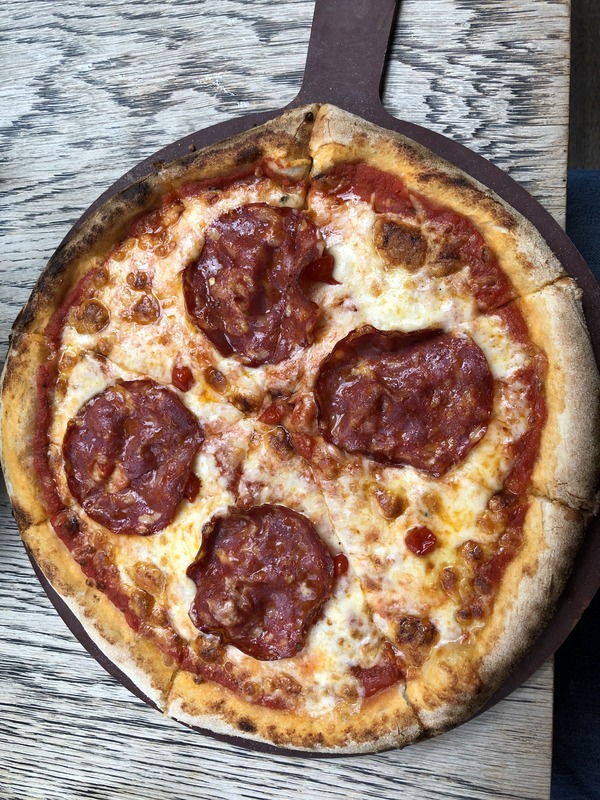

You will not believe it, but this vegetarian pizza was mine. I don’t know what came over me, and I promise it won’t happen again!
After lunch, we strolled around the corner toward Old Square at Lincoln’s Inn. Last year, Wonder Woman became my all-time favorite film, and though most of it was shot on a backlot (and in Italy!), there are a few filming locations in London I wanted to try to see on our trip. Old Square is where they shot Wonder Woman’s arrival in London, and I thought we could just walk right up to the spot.
First we tried to get there via a gate just to the left of this building.

But there was a security barrier and a booth attendant who was quite insistent that no one could enter, even on foot. We weren’t the only ones interested in getting in—they turned away several other groups of tourists.

Yeah, they are super-serious about this no-entry thing at Lincoln’s Inn
Our disappointment was short-lived as we were immediately distracted by this marker for the Queen’s Silver Jubilee in the street.

Ooooh looky! A monarchy thingy!
We decided to walk all the way around the campus and see if the opposite gate was admitting visitors. This took twice as long as it should have because Patrick stopped every three feet to take a photo. Apparently only these turned out:
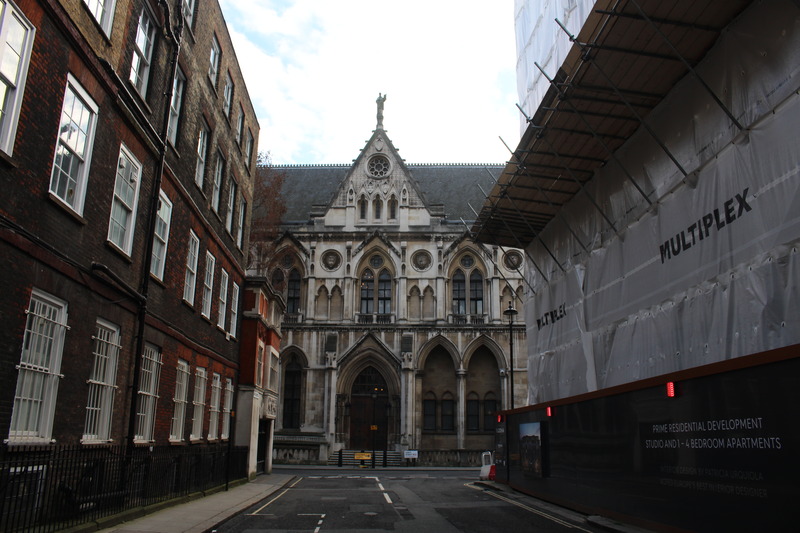


I was super-bummed to discover the gate on the opposite side was unmanned and locked. Of course, all this could have been avoided if I’d done a simple Google search and seen that the grounds at Lincoln’s Inn are only open on weekdays. I don’t know how, in all my copious planning for the trip, this simple detail escaped me. I will blame it on needing the brain space to store the French phrase for “Where do you keep the cake, and may I please have all of it?”

If you look through the bars and toward the left at the back, you can just glimpse the edge of the square that was used in the movie. Great photo tour, eh?
We decided to hop the Tube and head for Kensington Palace. Along the way we stumbled on Patrick’s favorite building again, Staple Inn, one of the few remaining Tudor structures in London! It dates to 1585, when it was used as a wool “staple”—a place where wool was weighed and taxed. Unlike most other Tudor structures, it survived the Great Fire of London, and even the Nazi Blitz. The two peaks on the right actually belong to a house the same age as the original wool staple that has since been incorporated into the inn.
I give you…. Photo Practice!
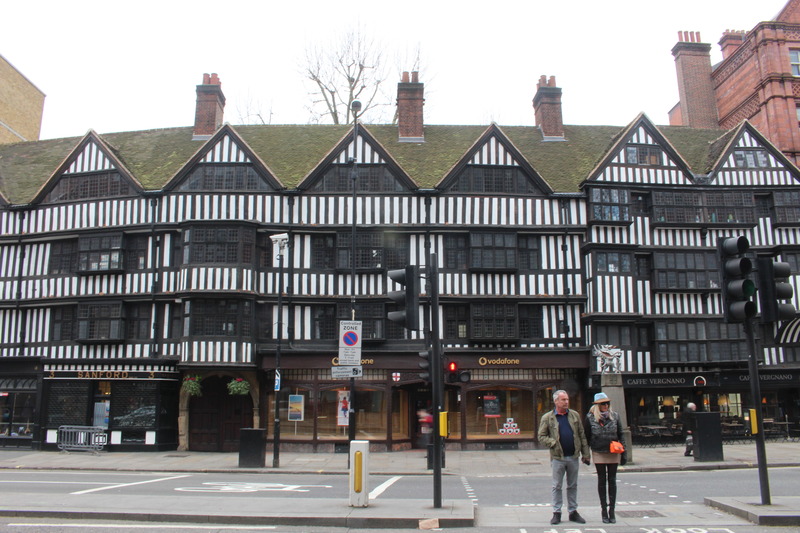



Nice juxtaposition of architectural styles here… I’m gonna say they’re “Tudor,” “Fancy-Style” and “Modern Bore”

I dunno… I feel like putting a dragon on your city entry marker says “Keep out!”

Even the Tube is a great place to practice taking photos!



We got off the Tube at Queensway and hoofed it through Kensington Gardens toward the palace. Kensington Palace is interesting because it is both a museum and a working royal residence. The state rooms are open to the public, but the rest of the place is divided into apartments for people like the Duke and Duchess of Cambridge (if you remember Princess Margaret renovating her nest in ’60s mod style on The Crown, that apartment now belongs to William & Kate, who completely renovated it again!), Prince Harry (I hear his one-bedroom will be for rent again soon), Princess Eugenie and a raft of lesser known royalty. In fact, Kensington Palace has been a sort of dormitory for people related to the crown since the end of Victoria’s reign, to the point that waggish Edward VII (the one who abdicated for Wallis Simpson) referred to it as “the aunt heap.”
Initially I was interested in Kensington Palace because it is where Queen Victoria grew up, and they have an extensive exhibit of her personal belongings and furnishings in the preserved suite of her rooms. But these were being refurbished during our visit, so the palace was downgraded to “if we have time” status. We ended up having time, and since it’s included free in the annual membership we bought to Historic Royal Palaces for skip-the-line access to the Tower of London, we gave it a go.
This statue of Queen Victoria in her coronation robes was sculpted by her daughter, Princess Louise Caroline Alberta. Canadian readers might be interested to know that the province of Alberta was named after her, as well as Mount Alberta and Lake Louise. She is also famous for having the windows of her apartment in Kensington Palace bricked up after discovering her husband climbing through them one night to visit a lover!


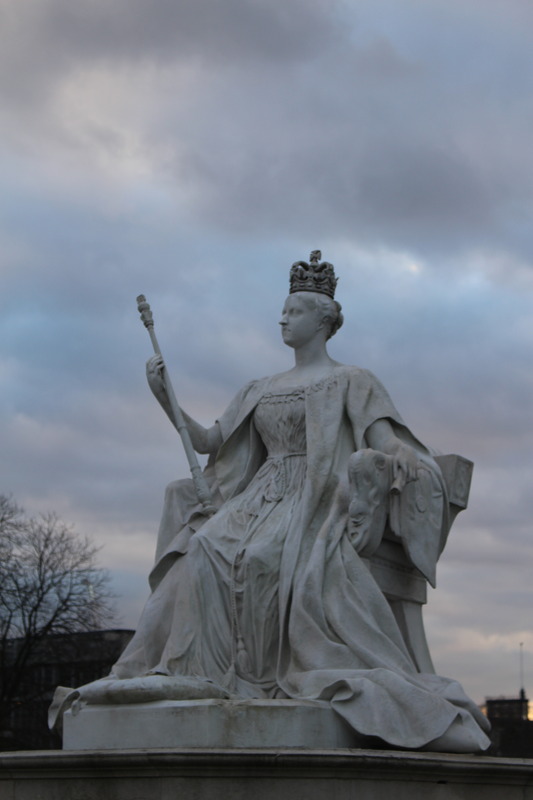

Another sinking building?! London’s really gotta get on that!!!


We were pleasantly surprised to learn that a simplified version of the Victoria exhibit was open during the renovation. Although there was barely anything in them, we did get to see the room where she was born and the room where she held her first privy council meeting the morning she was awakened with the news that her uncle had died and she was now Queen of England.
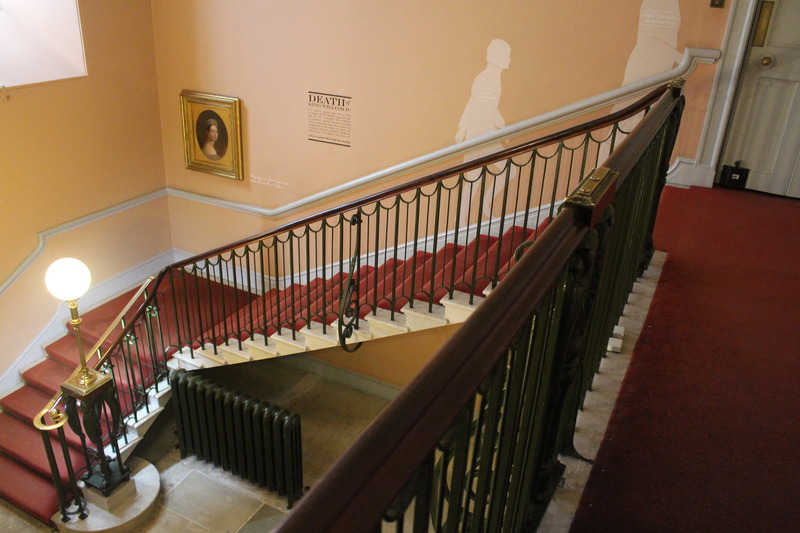
One of the rooms had a small exhibit on Victoria and Albert’s love story. My favorite piece was this veritable boudoir portrait Victoria had painted to give to Albert as a birthday present. She usually looks so severe in paintings and photos—I feel like I’ve never seen her looking so fresh and natural.
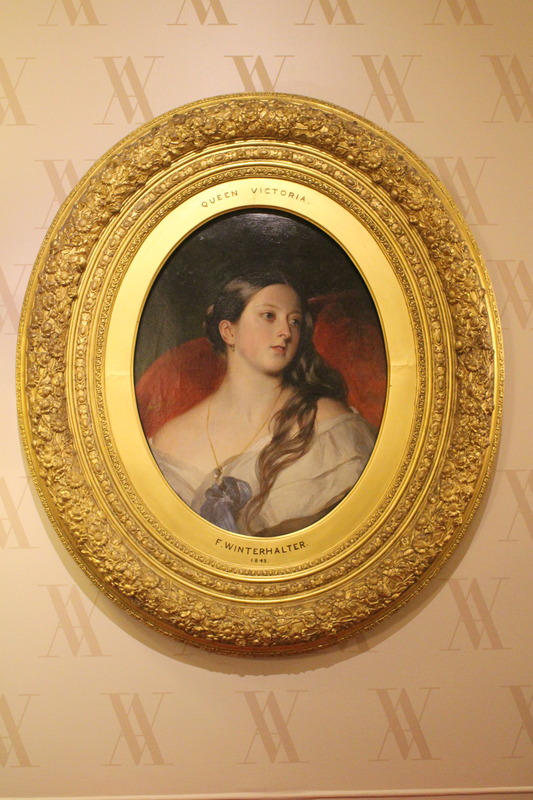
Check out this quote from one of Albert’s letters — our wedding anniversary is February 4th! (Victoria & Albert’s anniversary ended up being the not-nearly-as-awesome February 10th.)

I have to think this uniform of Albert’s is a reproduction cuz it isn’t in a case. Or maybe Kensington Palace also employs the Soane museum’s Sharp Scolding method of preservation.



Princess Victoria’s doll house

The rest of the palace is more about its first royal owners, King William III and Queen Mary II, as well as later occupants King George I and King George II. I gotta be honest with you, it was not that interesting to me. Maybe if we’d gone here before Buckingham Palace I would have been more impressed.
Also, all I remembered about William & Mary is that there’s an American college named after them. Oh! And that William was basically invited by the British to invade their country (he was Dutch) and depose his wife’s father, who was Catholic. And that Catholic-phobia (in the form of the Act of Settlement 1701) was the same reason they tracked down 52nd-in-line George Louis of Hanover to succeed Queen Anne as George I. Golly, I guess those Monarchy DVDs really worked!
This is the King’s Grand Staircase, in which William Kent depicted 45 members of George’s royal court, as well as himself and his mistress. (I wonder what Mrs. Kent thought at the unveiling ceremony!)
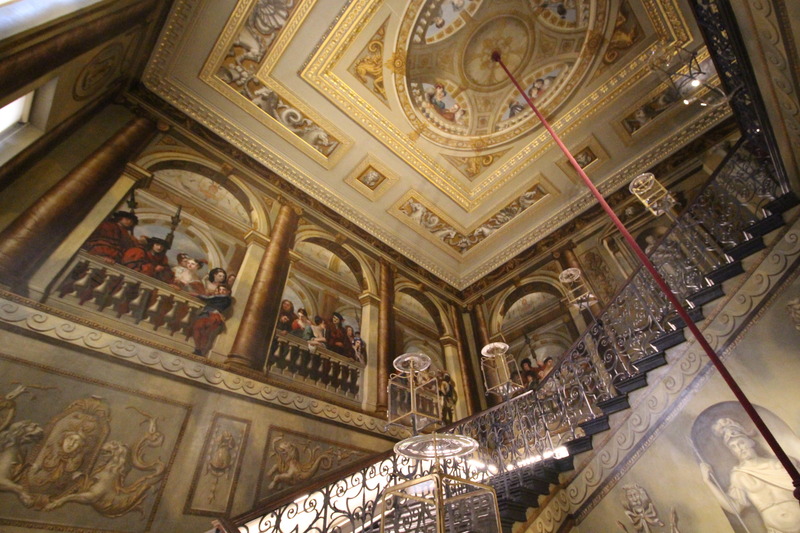



Sheesh! All that money and he couldn’t afford real columns? 🙂
The King’s Gallery is the largest stateroom in the palace and looks almost as it did when King George I had it done over by William Kent in 1725. Kent also did the ceiling paintings of scenes from the life of Ulysses.


Over the mantle is a dial connected to a wind vane on the roof that showed King William which way the wind was blowing, where his navy was probably heading and when the mail would arrive. Note the way the wind dial depicts Great Britain (erroneously) as being the same size as France!
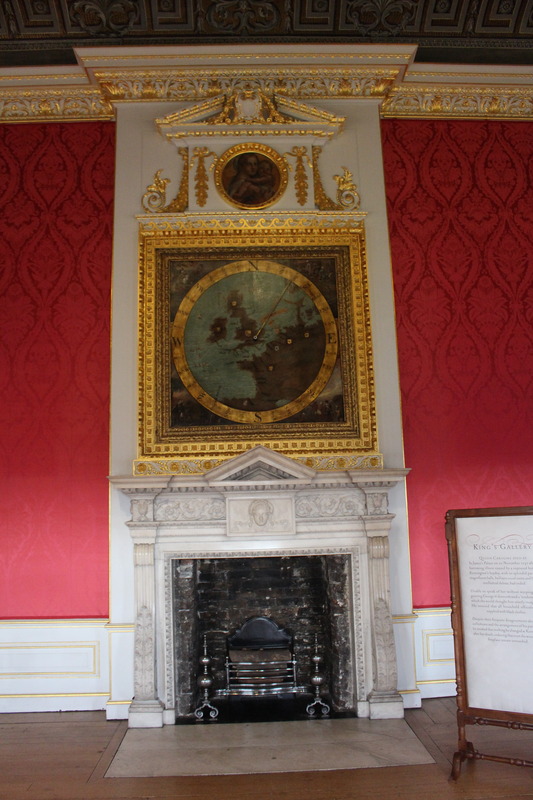
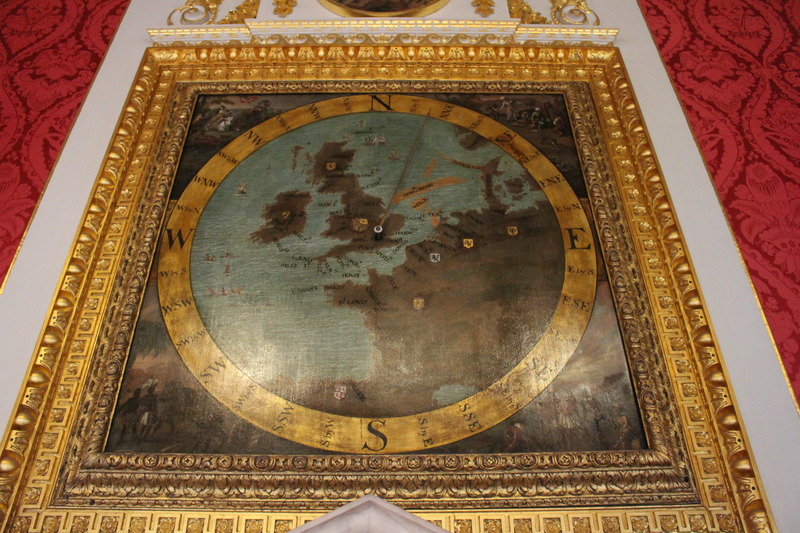
The gardens were redesigned by King George II’s wife, Queen Caroline, in the mid-1700s and retain the “new” look today.
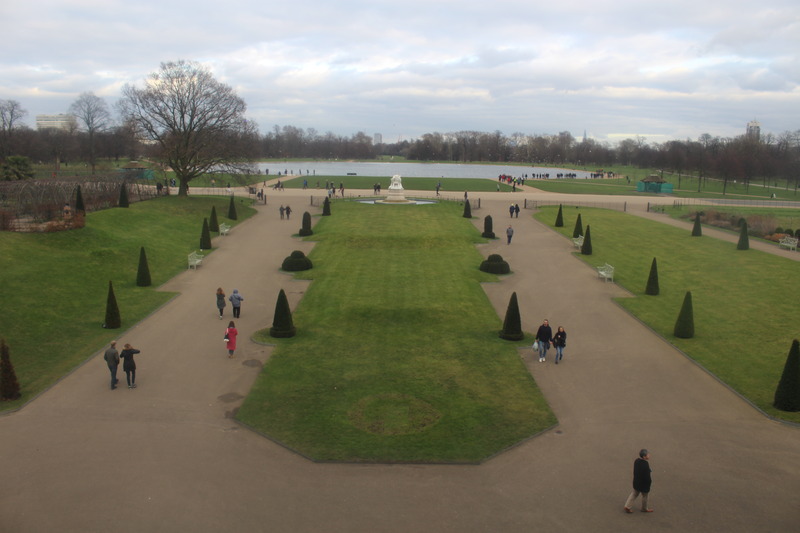
The Cupola Room was the first project designed by William Kent and the most opulent of all the rooms in the palace. (The King’s Grand Staircase was his last project—see: Mrs. Kent.) Kent was an architect, furniture designer, scenic painter and landscape architect who eventually defined the look of Georgian period architecture and decorative arts—all because he beat Sir James Thornhill’s bid for decorating this room!

At the center is a huge musical clock. It once contained an organ that played pieces by Geminiani, Handel and Corelli, but this was removed in the 1800s (probably because there’s only so long you can stand to hear the “Hallelujah Chorus” on the hour, every hour!).

The paintings on the clock’s four faces represent the four ancient Monarchies of the World: Assyria, Persia, Greece and Rome.

King William III’s Baroque throne chair….

We instantly recognized this room from an episode of Monarchy where they talked about the birth of King James II’s son, James Edward Stuart, in this bed. Because he was Catholic, the Protestant establishment spread bizarre rumors that the baby was an impostor smuggled into the bed in a warming pan to replace a stillborn baby. Even crazier, he actually was smuggled out of the palace in some laundry a few months later during the “Glorious Revolution” that overthrew his father and brought William and Mary to the throne!

The Queen’s Gallery is a bit more sedate than the King’s Gallery (maybe cuz William Kent never got his mitts on it).

She also had her own, much less showy staircase.

See! Even somebody who lived in the palace had to embroider a family tree to keep all their kings and queens straight!
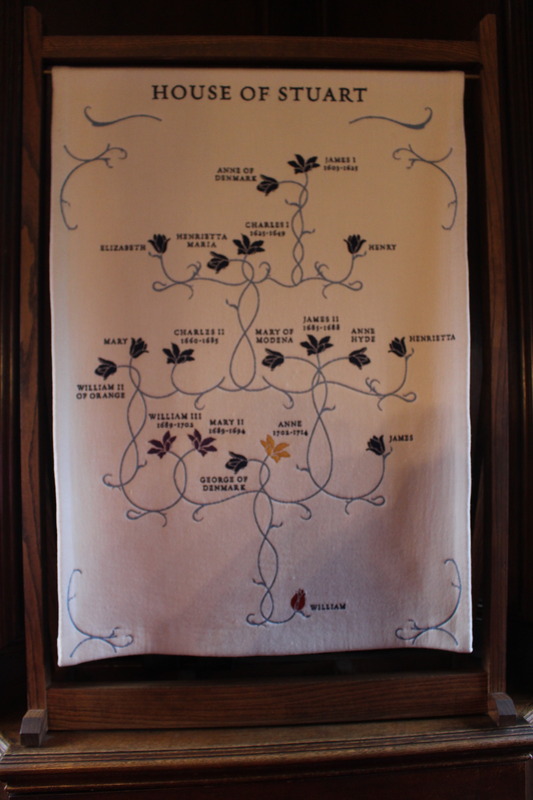
On the bottom floor is the Diana: Her Fashion Story exhibit, which runs till January 6, 2019. It wasn’t quite as large as the exhibit we saw at the Queen Mary in Long Beach a few years ago, but it’s a similar idea, and really well done. The exhibit charts her rise from “Shy Di”—a girl whose entire wardrobe comprised one dress, one shirt, and one nice pair of shoes because she borrowed the rest from friends—to one of history’s style icons.
I particularly liked the costume sketches with fabric swatches. Who knew the dress she wore to Prince William’s christening was so bright? The swatch is practically neon in person!

My favorite of all the gowns was this one designed by Catherine Walker for Di’s visit to Saudi Arabia. With its sequined falcons (the national bird of Saudi Arabia), high neckline and long sleeves, it perfectly encapsulates how she would work with designers to create something themed to the host country and respectful of local customs yet still stunning!

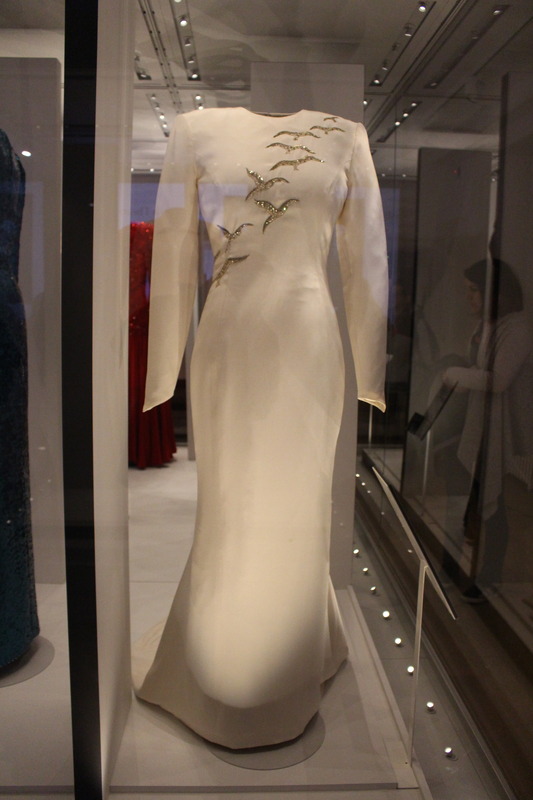
On our way out, Patrick shot the newly renamed White Garden, which was replanted last year with 12,000 mostly white flowers to commemorate the 20th anniversary of Princess Diana’s passing. As it was February, we saw about 12 of those 12,000 flowers, but you can see some great shots of the garden in full bloom here!

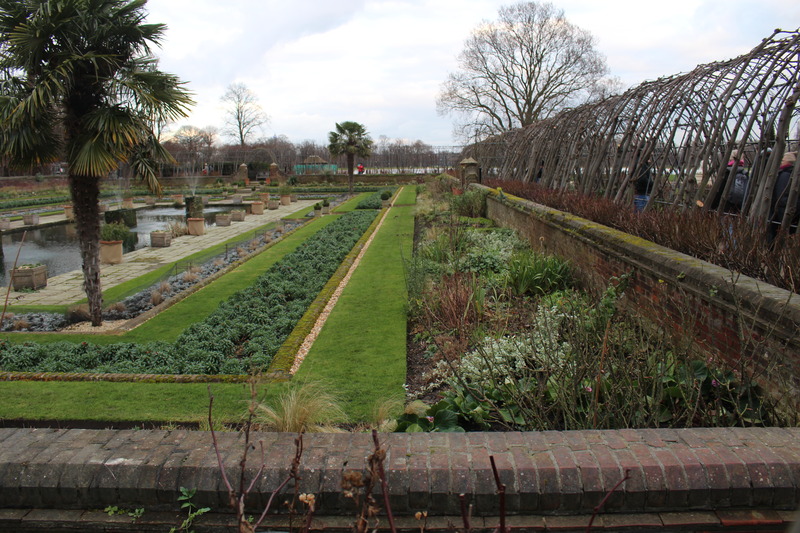
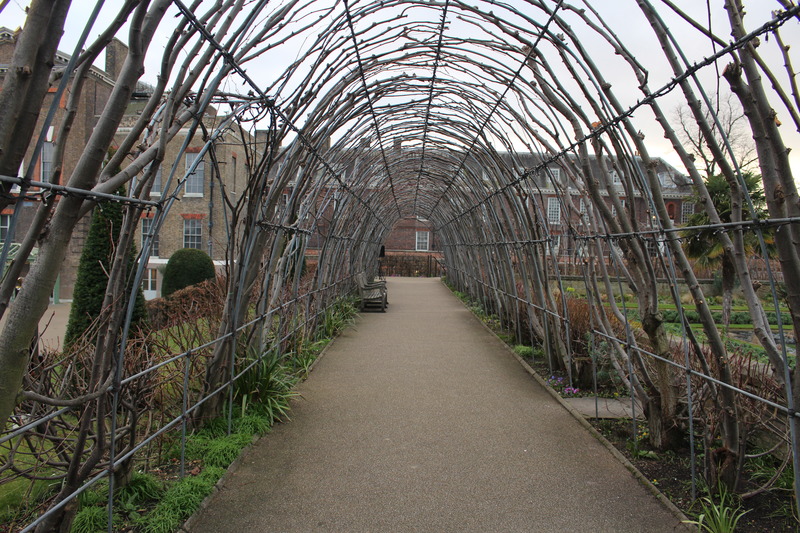

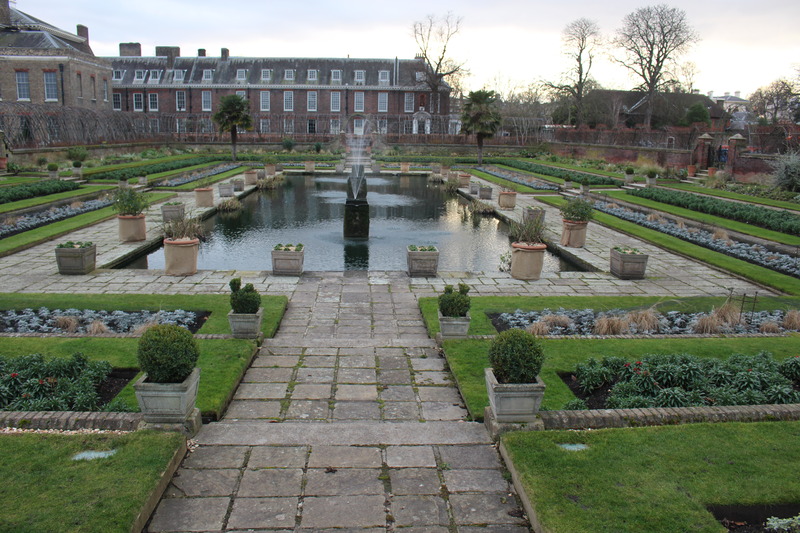

We shut down Kensington Palace (like, the guards were literally shooing me away from the doors as I desperately hung on to the free WiFi) but still had some time to kill before we needed to be at dinner. I’d made all of our dinner reservations around 8pm so that we would never feel rushed while the museums were open, but sometimes that left an awkward gap.
I decided to show Patrick Leceister Square, my old stomping grounds when I was too young to have taste yet. It turned out to be just as commercial as it was 20 years ago, if not moreso, but there’s also a nice grassy central area now thanks to the 2012 Olympics-related renovation. I was bummed but not surprised to see that the Häagen-Dazs had been replaced. It was a full-blown cafe, with table service and a real menu of desserts like fondue and waffle sundaes. They used to serve this flavor you couldn’t get in the States called Chocolate Midnight Cookies: Chocolate ice cream with chocolate cookies and huge pockets of fudge. Le sigh… Of course, now you can get ice cream with bacon in it, so what am I complaining about?
Patrick didn’t take any photos, so I went looking for a Wikimedia Commons image and, whaddya know—this shot from 2012 has my beloved Häagen-Dazs in it!

© Romazur
Leceister Square didn’t take very long, so I thought maybe Patrick should see Trafalgar Square. I won’t bore you with a history lesson on Trafalgar Square (though I was perfectly happy to bore you with one on a semi-obscure British architect!), but I will recommend this fascinating article on its history. And by “fascinating” I mean HIGH-larious in its choice of this image to illustrate the “Trafalgar Square’s Drinking Fountains” section:

“No YOU just pooped in this drinking fountain!”
The National Gallery was not on our itinerary for this trip because, well, we’re just not that into art museums. But when we got to Trafalgar Square, we noticed hordes of people streaming in and out of the Gallery and discovered that it’s kept open later than other tourist attractions in London—and free!—specifically so that art-averse American plebs like us will stumble in when everything else is closed. Well played, National Gallery!
Patrick didn’t take any photos of Trafalgar Sqaure or the exterior of the National Gallery either (I’m starting to see a theme to his photography here… Landmarks and monuments: No. Pigeons and safety bollards: Yes!) so it’s Wikimedia Commons to the rescue again…

© DAVID ILIFF. License: CC-BY-SA 3.0
Well will ya lookit that? The National Gallery has the same dome as The Ritz! Say, wait a minute…..

Must’ve gotten the dates of my photo files mixed up!
When I lived around the corner, I loved the fact that I could pop by and see a real Van Gogh whenever I wanted. The National Gallery holds several famous Van Goghs, as well as Monets, Rembrandts and Michelangelos. Which makes it the perfect place to catch up on your Instagram feed…

“How many times is that cat gonna flush the toilet?!”
What’s so funny to me is that, because photography is allowed, all the famous works are surrounded by crowds desperately trying to snap cell phone photos of paintings instead of actually looking at them. If you like the art, why not get a postcard or poster or some other format that actually, like, looks good? (And yes, Patrick took a bunch of his own cell phone photos, but only for YOUR benefit, Dear Reader!)

“Oh yeah! This photo’s going over the mantel!”

“Perfect for that blank space above the toilet!”

“I’m thinking… kitchen!!!”

“The baby will love falling asleep under this one!”

“Well, it’s no ‘Dogs Playing Poker,’ but I guess it’s good enough to put in the poolhouse…”

“Bonus art! Three paintings in one shot!”

“Honey, shoot the plaque too so people will know what it is!”
I’m no connoisseur, so I got inordinately excited over being able to identify this painting as a Canaletto, thanks to our trip to the Soane Museum.


Canaletto did an awesome job on this Epcot concept art!

This is The Ambassadors by Hans Holbein the Younger, who in 1533 painted the first Highlights magazine back cover. Check it out….

Head-on…

From the side….
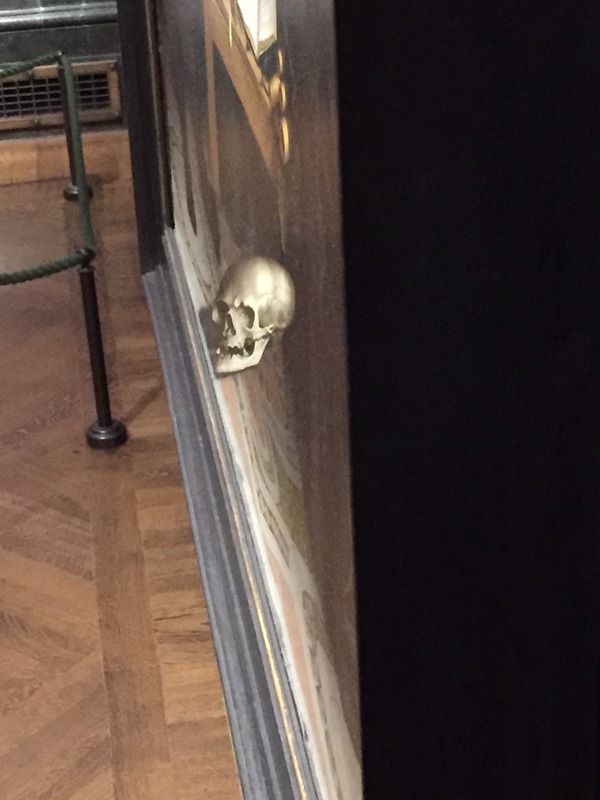
Satisfied that we’d gotten our (no) money’s worth, we headed around the corner to our hotel and got ready for our anniversary dinner at Duddell’s London. It is the first outpost of the famous Duddell’s in Hong Kong, and I chose it because it’s inside a former church (and, it turns out, turn-of-the-century operating theater… gack!) so I thought Patrick would get a kick out of it. Also, he loooooves dim sum. Heck, I love dim sum—who doesn’t?
We grabbed a cab and got our first and only female cabbie of the trip! When she told us that thing about less than 3% of London cabbies being female, we asked why that is. She theorized that women have too much family responsibility to have the time to learn The Knowledge (that 3-year test you have pass to get a license). She said she only took it up because her brother passed on and she needed something to distract her, but that she’s found it quite rewarding.
We weren’t sure she’d let us out in the right place at first (how could we have doubted The Knowledge?) because it didn’t look much like a church at ground level, in the dark. Here’s a glamour shot from the restaurant so you can see how cool it is!

© Duddell’s
There are two reasons I wish we’d had lunch here instead of dinner: 1) They only serve the full dim sum menu at lunch and 2) It’s hard to get really great shots of the place without light streaming in the windows! Fortunately, Duddell’s website has a ton of glamour shots—please indulge me while I post a bunch.

© Duddell’s – Ed Reeve

© Duddell’s – Ed Reeve

© Duddell’s – Ed Reeve

© Duddell’s – Ed Reeve

© Duddell’s – Ed Reeve

© Duddell’s – Ed Reeve

© Duddell’s – Ed Reeve
So this is what it looks like at night….
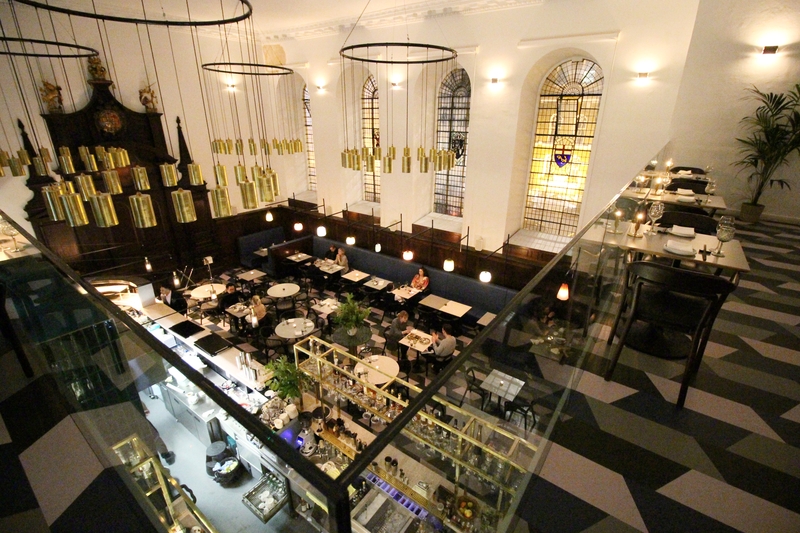


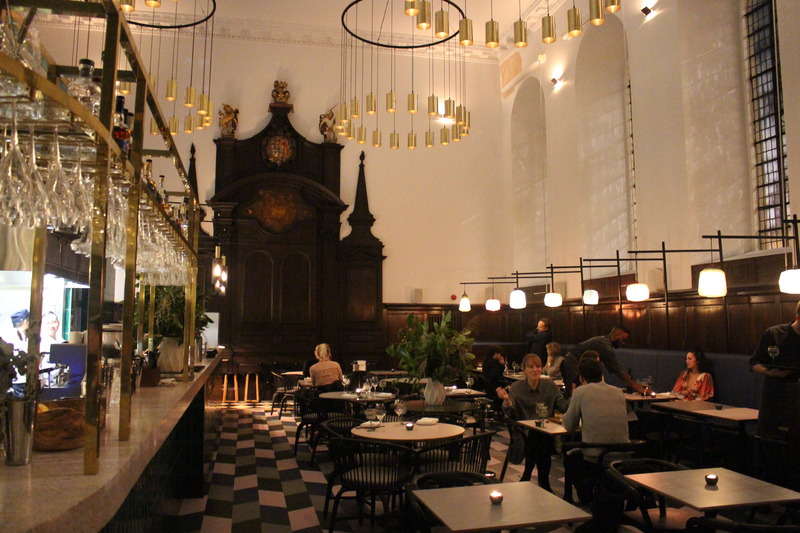
We really enjoyed our meal here—like Top 2 of the entire trip! It felt like a San Francisco or New York restaurant, but in a good way. If we had one of these in LA, we’d be there a lot.

“Best anniversary EVER! Thanks for planning this, Carrie! You’re the best wife I ever had and everything you do is art!”
I ended up being glad we’d gone for dinner because it allowed us to get THE best Peking Duck I’ve ever had. You only need a half order for two people, and what you don’t finish the first go-round, they bring back to you later.

Quack!

Here’s another official glamour shot, because we ate it too quickly to get photos:

© Duddell’s
From the menu: “Using classic Cantonese spices, this iconic dish takes over 48 hours to prepare. The duck is air-dried in order to separate the skin from its meat, resulting in delicately crunchy skin which melts in the mouth. Served with 8 types of condiments, diners can create their own combination of texture and taste…with fennel sugar, aged mandarin and sesame dressings, white wine bean sauce, pomelo, pineapple, cucumber and spring onion. ”
(Don’t worry, that’s just a dangling participle: Diners are not the ones being served with 8 types of condiments!)

This is the best shot we got and I can’t figure out what this is! Maybe some of the leftover duck that they brought back?

Egg Fried Rice and Honey-glazed Char Siu Pork
We also got the Dim Sum Symphony appetizer, which was the perfect taste of their full dim sum menu. I love how the one on the top left looks like he’s rallying the rest of them in a jailbreak….


“Right, you lot, ‘ere’s ‘ow it’s gonna go! Knuckles, Mumbles, Steve: You jump onna Daniel Boons and catapult right frew da Tommy Trinder!”

“Vinny, Sparkles—you geezers ain’t got eyes, won’t make it off the Aunt Mabel! Best duck and dive inna hot mustard while I have a butchers.”

“Crickey! We’re blown! Everybody scapa!!!”
After dinner we walked to the Tube stop just around the corner and headed for Leicester Square Station.
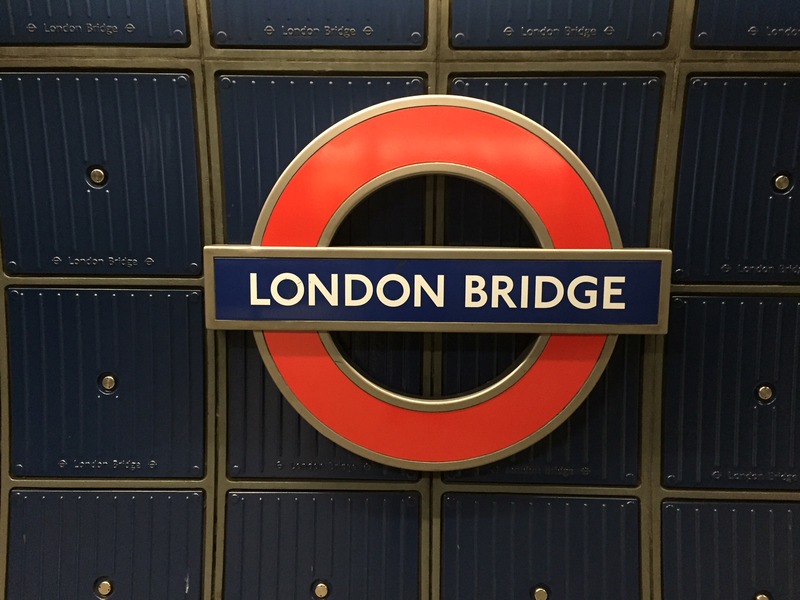
When we got there, I confidently sashayed out one of the four exits without looking at which one it was or where it would put us. The trouble is, there are a bunch of streets that cross each other all around the station, and I got hopelessly turned around in the dark. It was also unexpectedly sketchy in this central, highly populated area of the city on a Sunday night at 10:00. For some reason, the only people we encountered were menacing drunks and people talking to themselves very forcefully. I became so rattled that when I spotted the familiar green glow of a Shake Shack, I lunged for it like it was the last lifeboat on the Titanic.
So I broke my cardinal rule of avoiding American chain restaurants while traveling abroad, and it was totally worth it. I’d been kicking myself all day that I hadn’t ordered any kind of cake or special, non-hazelnut/coffee/white chocolate dessert to celebrate our milestone anniversary. But here we were, on the 10th anniversary of our fabulous Disney wedding, nursing chocolate Concretes at a Shake Shack 5,000 miles from home, and somehow it was the perfect way to celebrate. Afterward, Patrick took things in hand and hailed a black cab for the embarrassingly short ride back to our hotel. Whew!

